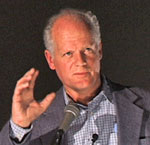


David Talbott
 David Talbott was the founder and publisher of Pensée magazine’s ten-issue series, "Immanuel Velikovsky Reconsidered." The series achieved international recognition in the 1970’s as the most authoritative treatment of the Velikovsky controversy.
David Talbott was the founder and publisher of Pensée magazine’s ten-issue series, "Immanuel Velikovsky Reconsidered." The series achieved international recognition in the 1970’s as the most authoritative treatment of the Velikovsky controversy.
The first issue became the number one best seller on several college campuses and inspired stories in Readers Digest, Analog, Time Magazine, Newsweek, Physics Today, Chemistry, Industrial Research, World Medical Tribune, and numerous other publications. Portions of the Pensée series were published by Doubleday as the book Velikovsky Reconsidered.
As a result of worldwide publicity (and 75,000 copies through three printings of the first issue), both the British Broadcasting Corporation and Canadian Broadcasting Corporation showed documentaries on Velikovsky, and both programs were re-broadcast due to popular interest.
In 1975 Talbott received a large advance from Doubleday for The Saturn Myth, based on an article he had written for Pensée—"Saturn: the Polar Night Sun"—and an outline. This was said to be the largest advance the company had ever given a previously unpublished and unknown author. The Saturn Myth was published in 1980.
Talbott has been on numerous national talk radio programs (including Art Bell, Whitley Strieber, Jeff Rense, Laura Lee, and Zoh Hieronymus), plus dozens of regional programs. Many hosts will testify that the programs were among their best ever. He has been invited to give presentations across the U.S, Canada, and Europe.
At various events he has shared the stage with
Oxford University astrophysicist Victor Clube, co-author of Cosmic Winter and Cosmic Serpent
the distinguished astronomer Halton Arp, author of Seeing Red
astronomer Tom Van Flandern, formerly with the Naval Observatory
Anthony Peratt of Los Alamos Laboratories, the recognized leader in the field of plasma cosmology
Robert Bass, former chairman of the astronomy department and mathematics department at Brigham Young University
Roger Wescott, founder of the anthropology department, Drew University, and founder of the Canadian and American Linguistics Association
Vine Deloria, one of the country’s most popular Native American authors
and dozens of other well-accredited scientists and scholars
Talbott’s work was the subject of a 90 minute documentary film, "Remembering the End of the World,” a film made prior to any of his present relationships with leading scientists.
Then, in 1997, he developed a close alliance with Australian physicist Wallace Thornhill, and the two began working on projects together. A breakthrough came in September 2000, at a conference in Portland, Oregon, at which Talbott and Thornhill began a close working relationship with a noted plasma theorist. In 2001 that relationship culminated in a plasma experiment at the most sophisticated laboratory in the world, the results of which astonished even the plasma experts, while confirming a vital tenet of Talbott’s hypothesis.
The story of this experiment will provide a climactic turn in the forthcoming book Thunderbolts of the Gods, co-authored by Talbott and Thornhill. The new support from plasma experiments has now altered the life’s work of more than one specialist in fields directly impacted by the hypothesis. One result is that Talbott has received personal and financial support from the Overseer Emeritus of one of the most distinguished archaeology museums in America.
A new program on planetary catastrophe has been established at a major Eastern university. The Near Eastern Studies and science programs at this university are among the most respected in the world.